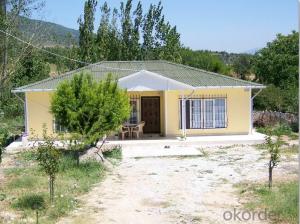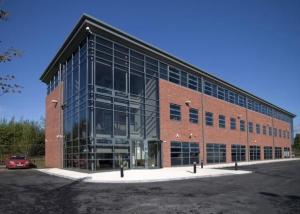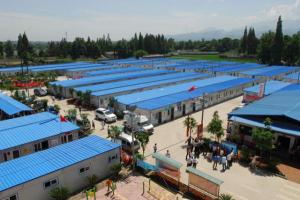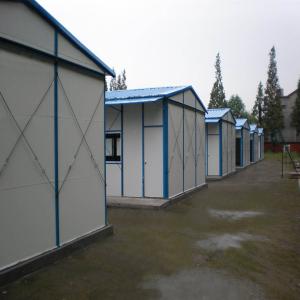Cheap and good quality mobile house
- Loading Port:
- China Main Port
- Payment Terms:
- TT OR LC
- Min Order Qty:
- -
- Supply Capability:
- -
OKorder Service Pledge
OKorder Financial Service
You Might Also Like
Specifications
Specifications prefabricated homes
1.Qualified material
2.Flexible design
3.Fast installation
prefabricated steel building Feature:
* Prefabrication, easy to install and disassemble
* Precision works, long life-span up to 15 years for use
* Lightness, easy to transport and relocate
* Using several times and recycling, economy and environment friendly
Prefab house Main material list as following:
Wall: 50mm/75mm thick EPS/Rockwool/PU sandwich panel
Roof: 50mm/75mm thick EPS/Rockwool/PU corrugated sandwich panel
Window: UPVC or Aluminum sliding window
Door: aluminum frame with panel same as wall panels(security door as optional)
Prefab house Joint material: steel column/aluminum alloy
1. Free from the damages by inspects, such as white ants and so on
2. Steel code: Q345, Q235
3. Designed life span: more than 30 years;
4. Green and environment-friendly materials used;
5. Seismic resistance up to 8 magnitudes
6. Safe---Able to stands for maximum 55 m/s typhoon
7. Advanced roof and wall cladding material guarantee excellent acoustic insulation, less 65% energy consumption than the concrete structure.
8. Additional 10%-15% net area compared to the traditional building, air cavity between the cladding and main structure guarantees the comfortable indoor space.
Prefab house advantage
1. Easy and quick to install;
2. Excellent load and span capabilities;
3. Significant savings in site installation costs;
4. Panel comes in a range of aesthetically pleasuring colors;
5. Energy saving thermal insulation;
6. Superior air tightness for controlled environments;
7. Good reactions to fire properties;
8. Durable, long lasting, stood the test of time in the extremes of harsh climate
- Q:What are the advantages of the container house?
- Second, durable, all composed of steel, with a strong anti-seismic, anti-deformation ability
- Q:How do container houses handle natural light?
- There are multiple ways in which container houses manage natural light. To begin with, they can utilize large windows or glass doors to allow abundant sunlight into the space. These windows are strategically positioned to optimize the amount of natural light that enters the house. Furthermore, skylights can be installed on the roof of container houses to bring in even more natural light. Another technique employed by container houses to handle natural light is the use of light-colored interior finishes and materials. Light-colored walls, ceilings, and floors reflect and enhance natural light, resulting in a brighter and more spacious atmosphere. Lastly, container houses can integrate various shading devices like blinds or curtains to regulate the amount of sunlight that enters the house and prevent overheating during hot summer months. All in all, container houses prioritize the utilization of natural light to create a welcoming and well-lit living environment.
- Q:Can container houses be financed?
- Yes, container houses can be financed. There are various financing options available such as personal loans, mortgages, or construction loans that can be used to finance the purchase or construction of container houses. However, the availability and terms of financing may vary depending on factors such as the location, size, and condition of the container house, as well as the borrower's creditworthiness.
- Q:Are container houses suitable for remote educational facilities?
- Remote educational facilities can indeed benefit from the use of container houses. These dwellings have gained popularity in recent years due to their versatility, affordability, and ease of transportation. These attributes make them an excellent option for remote locations where traditional construction may pose challenges or come at a high cost. One advantage of container houses is their easy transportability, which allows for the establishment of educational facilities in otherwise inaccessible areas. This is particularly advantageous for communities located in remote regions with limited infrastructure and resources for education. Moreover, container houses can be customized and adapted to meet the specific needs of educational facilities. They can be designed to accommodate classrooms, libraries, laboratories, and other essential spaces. By ensuring proper insulation, electricity, and ventilation systems, container houses can offer a comfortable learning environment. Another benefit of container houses is their cost-effectiveness when compared to traditional building methods. This affordability enables more resources to be allocated towards educational materials, technology, and staff, thereby enhancing the overall learning experience. Additionally, container houses are environmentally friendly. They are often constructed from recycled materials and repurposed shipping containers, which minimizes waste and reduces the environmental impact. This aligns well with the growing emphasis on sustainability in educational institutions. In conclusion, container houses are a viable option for remote educational facilities. Their portability, customization potential, affordability, and eco-friendliness make them an attractive choice for establishing educational infrastructure in remote areas.
- Q:Are container houses suitable for student or workforce housing?
- Yes, container houses can be suitable for student or workforce housing. They are cost-effective, can be easily transported, and can be customized to provide comfortable living spaces. Additionally, container houses are environmentally friendly as they make use of recycled materials.
- Q:Can container houses be designed for adventure or outdoor tourism accommodations?
- Yes, container houses can definitely be designed for adventure or outdoor tourism accommodations. Container houses have gained popularity in recent years due to their versatility, affordability, and sustainability. They can be easily modified and customized to fit various needs and environments, making them an excellent option for adventure or outdoor tourism accommodations. Container houses can be designed to blend seamlessly with the surrounding natural landscape, creating a unique and immersive experience for tourists. They can be placed in remote locations such as national parks, forests, or mountains, offering visitors a chance to connect with nature while enjoying comfortable accommodations. These houses can be equipped with various amenities and facilities to cater to the needs of adventure tourists. For example, they can include outdoor equipment storage spaces, drying rooms for wet gear, and built-in hooks or racks for hanging and drying equipment. Additionally, container houses can be designed to be eco-friendly, incorporating sustainable features such as solar panels for energy generation and rainwater harvesting systems. Furthermore, container houses can be easily transported and assembled, allowing for quick setup and dismantling. This flexibility makes them ideal for temporary or seasonal adventure tourism accommodations. They can be used as base camps for hiking or mountaineering expeditions, cycling or motorcycling tours, or even as glamping sites for those seeking a unique outdoor experience. Overall, container houses offer a practical and innovative solution for adventure or outdoor tourism accommodations. They can be designed to meet the specific requirements of the location and the needs of the tourists, providing a comfortable and sustainable stay while embracing the spirit of adventure and outdoor exploration.
- Q:Can container houses be designed to have multiple bedrooms?
- Indeed, it is possible to design container houses with multiple bedrooms. The versatility of container houses enables them to be tailored to various spatial needs. By stacking and connecting multiple containers, one can create a larger layout that can accommodate multiple bedrooms. Some container house designs employ the technique of placing two or more containers side by side to form a broader living area that can be divided into separate bedrooms. Additionally, containers can be modified by incorporating walls, windows, doors, and insulation to establish individual rooms within the structure. This adaptability in design allows for the construction of container houses with multiple bedrooms, thereby rendering them suitable for families or individuals seeking additional living space.
- Q:Are container houses easy to transport?
- Container houses are indeed quite easy to transport. Their portability is one of the key benefits they offer. These houses are specifically designed to be transported by trucks, trains, or ships, making them an ideal choice for those who frequently relocate or prefer living in remote areas. The standardized measurements of shipping containers facilitate effortless loading and unloading, and they can be conveniently stacked or arranged in different ways. Moreover, container houses can be easily dismantled and reassembled at various locations, providing flexibility and convenience. In summary, container houses present a convenient and efficient alternative to traditional houses when it comes to transportation.
- Q:Are container houses suitable for student accommodation?
- Yes, container houses can be suitable for student accommodation. They offer several advantages that make them an attractive option for students. Firstly, container houses are affordable compared to traditional housing options, which is important for students who often have limited budgets. They can be purchased or rented at a lower cost, making them a more cost-effective choice. Secondly, container houses are highly customizable and can be converted into comfortable living spaces. With the right modifications, they can offer all the necessary amenities such as bedrooms, bathrooms, kitchens, and study areas. These houses can be designed to maximize space utilization and provide a comfortable living environment for students. Additionally, container houses are portable, allowing for easy relocation if needed. This flexibility is beneficial for students who may need to move frequently, whether it is due to changing universities, internships, or other reasons. Container houses can be transported to different locations, providing a convenient accommodation solution for students. Furthermore, container houses are eco-friendly as they are made from recycled shipping containers. This makes them a sustainable and environmentally conscious choice for student accommodation. With the increasing emphasis on sustainability, container houses align with the values of many students who are concerned about the environment. However, it is important to consider some potential drawbacks as well. Container houses may have limited insulation and may require additional heating or cooling measures. They may also have limited space compared to traditional houses, which could be a concern for students who require more room. Additionally, the availability of land and necessary permits for container houses may vary depending on the location, which could pose a challenge for student accommodation. In conclusion, container houses can be a suitable option for student accommodation due to their affordability, customizability, portability, and eco-friendliness. While there may be some limitations, these houses offer a practical and sustainable solution for students looking for affordable and flexible housing options.
- Q:Can container houses be insulated for extreme temperatures?
- Indeed, container houses can be effectively insulated to withstand extreme temperatures. Insulation plays a vital role in the construction of container houses, particularly in extreme temperature conditions. There are several insulation options to choose from, including spray foam insulation, rigid foam insulation, and fiberglass insulation, all of which effectively regulate the temperature within the container house. These insulation materials are specifically designed to offer exceptional thermal resistance, preventing the transfer of heat or cold from the external environment. Furthermore, it is crucial to ensure thorough sealing and insulation of the container house to avoid any air leaks that may compromise its energy efficiency. With proper insulation, container houses can be sufficiently prepared to endure extreme temperatures and establish a comfortable living environment indoors.
1. Manufacturer Overview |
|
|---|---|
| Location | |
| Year Established | |
| Annual Output Value | |
| Main Markets | |
| Company Certifications | |
2. Manufacturer Certificates |
|
|---|---|
| a) Certification Name | |
| Range | |
| Reference | |
| Validity Period | |
3. Manufacturer Capability |
|
|---|---|
| a)Trade Capacity | |
| Nearest Port | |
| Export Percentage | |
| No.of Employees in Trade Department | |
| Language Spoken: | |
| b)Factory Information | |
| Factory Size: | |
| No. of Production Lines | |
| Contract Manufacturing | |
| Product Price Range | |
Send your message to us
Cheap and good quality mobile house
- Loading Port:
- China Main Port
- Payment Terms:
- TT OR LC
- Min Order Qty:
- -
- Supply Capability:
- -
OKorder Service Pledge
OKorder Financial Service
Similar products
New products
Hot products





























